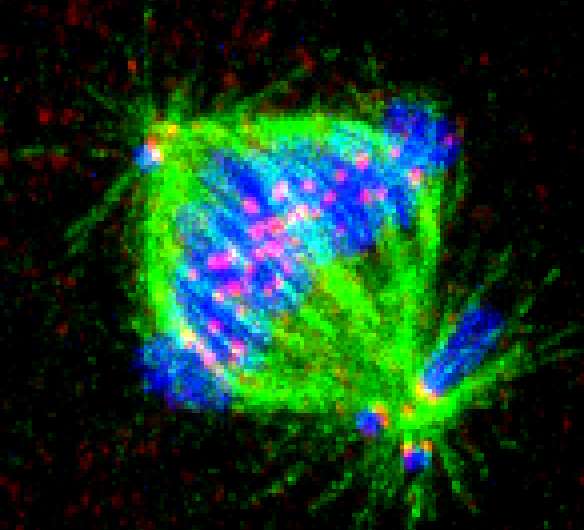Studies reveal details of error correction in cell division

Cell biologists led by Thomas Maresca at the University of Massachusetts Amherst, with collaborators elsewhere, report an advance in understanding the workings of an error correction mechanism that helps cells detect and correct mistakes in cell division early enough to prevent chromosome mis-segregation and aneuploidy, that is, having too many or too few chromosomes.
Aneuploidy is believed to promote tumorigenesis and tumor evolution in somatic or non-sex cells, and causes genetic disorders such as Down syndrome when it occurs in sex cells.
Maresca says his group's paper in the current issue of Current Biology, with a companion paper in the same issue by Michael Lampson and colleagues at the University of Pennsylvania, are the first to clarify the role of an enzyme called Aurora A kinase (AAK) in the error correction process and to discover the crucial importance of chromosome position in the spindle and how it affects division success.
"It's satisfying that we finally know the details of this pole-oriented error correction process," Maresca says. "It's a significant advance to understand that where you are as a chromosome in the spindle makes a difference to how well your kinetochore interacts with microtubules."
As he explains, when a cell prepares to divide, it moves through several steps to assure that each replicated chromosome segregates accurately and one copy of every chromosome moves toward opposite poles to become part of separate daughter cells. Structures such as the mitotic spindle, with its highly dynamic microtubules, and kinetochores form during cell division to support this.
The protein-based kinetochore is a large, complex protein-based structure that interacts with microtubules that grow and shrink by adding or subtracting subunits at their ends. The spindle positions itself like a long-armed referee ready to separate two fighters. Each replicated chromosome lines up in a configuration called bi-orientation as the spindle prepares to move copies to different corners or poles before the cell pulls apart into two daughter cells.
"As you can imagine," Maresca says, "it's not perfect. There are times when kinetochores interact with microtubules pointed toward the same pole instead of opposite poles. If they stayed in that position you'd end up with aneuploidy, the incorrect number of chromosomes. Cancer cells are highly aneuploid. If aneuploidy happens in sex cells it causes miscarriage in most cases because the cells cannot survive. Or it can lead to developmental disorders."
When cells make a mistake, the error correction process disconnects microtubules from the kinetochore and starts over again. The most well studied regulator of this process, Aurora B kinase B (ABK), was known to phosphorylate or chemically modify substrates, in this case other proteins, forcing kinetochore proteins that bind microtubules to let go of them.
Maresca, Lampson and colleagues studied ABK's close relative, AAK, which is found in high concentrations at spindle poles but its role was not understood. The researchers found that AAK activity contributed to locally destabilizing interactions between the kinetochore and spindle microtubules.
"This is the first time anyone has clarified the role of AAK in this process," Maresca says. "We found that as the bad attachments move toward the pole, they encounter high levels of this kinase activity. Looking at details of phosphorylation, which is a chemical reaction, we found evidence of an AAK phosphorylation gradient around spindle poles and this activity locally phosphorylated kinetochore proteins in a manner that is known to reduce the affinity of the kinetochore for microtubules."
He and colleagues did this work in Drosophila cells, but collaborated with Daniela Cimini's laboratory at Virginia Tech, where she found the same processes conserved in mammalian cells. "They saw very similar things as we were seeing in the fruit fly cells," he notes. Another collaborator, Julie Welburn, at the Wellcome Trust Centre for Cell Biology in Edinburgh provided evidence of the same process at work in human tissue culture cells.
Maresca says, "It is really satisfying to go from an unexplained phenomenon initially observed over 10 years ago, to now identifying the kinase, the molecular target of that kinase and then showing that it's conserved from Drosophila to human. To me this is really great because it's rare to achieve all of that in one set of studies."
In a commentary in the journal, observers point out that Maresca and colleagues' work "reveals that Aurora A and Aurora B share a common substrate for the correction of improper microtubule attachments." Further, the work "convincingly identifies the presence of an Aurora A-mediated error correction mechanism based on the destabilization of microtubule attachments near the spindle poles."
More information: Aurora A Kinase Contributes to a Pole-Based Error Correction Pathway, DOI: dx.doi.org/10.1016/j.cub.2015.06.021
Journal information: Current Biology
Provided by University of Massachusetts Amherst



















